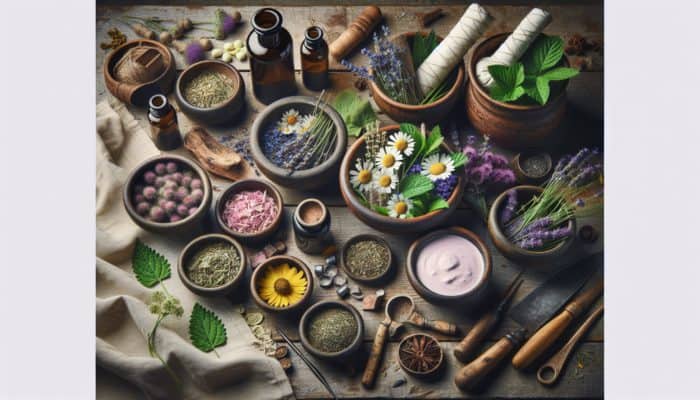Discover the Transformative Benefits of Ashwagandha for Mindfulness Fitness
Understanding Ashwagandha: A Key Component for Holistic Wellness

Ashwagandha, known scientifically as Withania somnifera, is a highly respected herb in the realm of Ayurvedic medicine, prized for its outstanding stress-relief properties. Recognized as a potent adaptogen, ashwagandha has found its place in the sphere of mindfulness fitness, where it aids the body in managing stress effectively, thereby nurturing both mental and emotional equilibrium. With a rich heritage spanning over 3,000 years, this remarkable herb has been traditionally utilized to enhance vitality, endurance, and cognitive clarity, making it an exceptional ally for those dedicated to mindfulness practices.
In today’s fast-paced environment, where stress often obstructs the journey toward inner serenity, ashwagandha emerges as a formidable ally. Its adaptogenic characteristics empower the body to finely tune its stress responses by regulating cortisol levels — a hormone that, when elevated, can compromise mental clarity and emotional stability. As more individuals gravitate toward natural solutions for improving mental health, the recognition of ashwagandha as an effective tool for cultivating a centered and mindful lifestyle continues to grow.
Unlocking the Secrets: How Ashwagandha Elevates Mindfulness Practices
Ashwagandha significantly enhances mindfulness by directly impacting cortisol, the primary stress hormone within the body. Elevated cortisol levels can induce anxiety and distractibility, severely impairing one’s ability to engage deeply in mindfulness activities such as meditation and yoga. By effectively lowering cortisol levels, ashwagandha fosters a tranquil environment that is essential for successful mindfulness practices. This extraordinary herb not only promotes relaxation but also boosts cognitive function, helping practitioners maintain focus during meditation sessions and other mindfulness endeavors.
Moreover, the cognitive-enhancing properties of ashwagandha facilitate a deeper engagement with mindfulness techniques. When the mind is liberated from the weight of stress, practitioners often experience an enhanced sense of presence and heightened awareness. This aspect is vital in mindfulness, where fully immersing oneself in the moment can profoundly affect the results of meditation and other exercises designed to cultivate mental serenity.
Practical Methods for Seamlessly Integrating Ashwagandha into Your Daily Life
Incorporating ashwagandha into your daily routine can serve as a simple yet impactful strategy to enhance your mindfulness journey. Options for integration include supplements, teas, and powders, each offering unique advantages tailored to your personal lifestyle. It is recommended to start with a modest dose to assess your body’s response, gradually increasing it to establish a customized approach for integrating this powerful herb into your life.
For individuals seeking convenience, ashwagandha capsules may be the ideal choice. Alternatively, incorporating ashwagandha powder into smoothies or herbal teas can make the consumption experience more enjoyable. It is crucial to be mindful of how you feel during mindfulness practices after introducing ashwagandha into your regimen. Being attuned to its effects will enable you to adjust the dosage or method of intake for optimal well-being and enhancement of your mindfulness practice.
Insights from Experts on Ashwagandha’s Role in Mindfulness Fitness
Professional Recommendations for Optimal Ashwagandha Dosage
Health experts commonly recommend commencing ashwagandha supplementation with a low dosage, typically ranging between 300-500mg per day. This dosage is deemed effective for the majority of individuals, but adjustments may be necessary based on personal experiences and preferences. Consulting with a healthcare professional before initiating any supplement regimen is crucial, as they can offer personalized recommendations, particularly if you have pre-existing health conditions or are on other medications.
As you start incorporating ashwagandha into your routine, pay careful attention to its effects on your mindfulness practices. Some individuals may discover that a higher dosage is beneficial for optimal results, while others might find satisfaction with lower levels. Additionally, the quality of the ashwagandha supplement you select is essential, as it can significantly influence its effectiveness. Opt for products that are standardized to contain a particular percentage of withanolides, the active compounds responsible for its therapeutic properties.
Enhancing Your Meditation Practices with the Power of Ashwagandha
Ashwagandha can profoundly enrich meditation practices by fostering relaxation and sharpening focus. Numerous users report experiencing a significant sense of calmness, which is critical for effective meditation. By alleviating stress and anxiety, ashwagandha enables practitioners to approach meditation with a clear and serene mind, thereby enhancing overall effectiveness. When incorporated into your routine, consider the following key benefits that ashwagandha brings to meditation:
- Lowered stress levels
- Enhanced cognitive clarity
- Increased relaxation
- Improved focus and concentration
- Greater resilience against distractions
- Support for emotional stability
Ultimately, the calming influences of ashwagandha prepare the mind for meditation, allowing individuals to fully reap the rewards of their practices. As practitioners report heightened mental clarity during meditation sessions, they often find it easier to remain present, leading to a more fruitful exploration of their inner selves and a deeper connection with mindfulness.
Expert Guidance on the Long-Term Use of Ashwagandha

Experts generally consider the long-term use of ashwagandha to be safe and beneficial, provided individuals remain vigilant about their responses. While numerous studies support its safety profile, professionals recommend taking periodic breaks to evaluate whether continued supplementation is necessary and effective. This practice helps to prevent tolerance and allows the body to reset naturally.
Additionally, it is crucial to stay aware of any potential side effects. Though ashwagandha is generally well-tolerated, some individuals may experience digestive discomfort or drowsiness. Regularly assessing how you feel and how ashwagandha impacts your mindfulness practice is essential. If you encounter adverse side effects, it may be prudent to lower the dosage or temporarily discontinue use. Consulting with a healthcare provider before making any changes can ensure safety and efficacy.
Exploring How Ashwagandha Enhances Other Mindfulness Practices
Ashwagandha effectively complements various mindfulness practices, such as yoga and breathing exercises. By alleviating anxiety and enhancing mental resilience, this powerful herb allows practitioners to engage more deeply in their practices. For example, during yoga, ashwagandha can help individuals maintain focus and presence during challenging postures, resulting in a more fulfilling experience.
Breathing exercises, often integral to mindfulness routines, can also reap the benefits of ashwagandha’s calming effects. By establishing a stable emotional and mental baseline, ashwagandha enables practitioners to concentrate on deepening their breath without the distractions of stress or anxiety. This harmonious relationship between ashwagandha and mindfulness practices underscores a holistic approach, where each element contributes to enriching the overall experience.
Harnessing the Benefits of Ashwagandha in Mindfulness Fitness
Key Stress-Reducing Advantages of Ashwagandha
Ashwagandha is widely recognized for its ability to lower cortisol levels, making it an essential tool for effective stress management. Elevated cortisol can lead to various issues, including anxiety, impaired focus, and a pervasive sense of chaos, all of which can significantly obstruct mindfulness practices. By alleviating these negative effects, ashwagandha nurtures a more supportive environment for mindfulness, allowing practitioners to engage fully and authentically.
The stress-reducing benefits of ashwagandha extend beyond mere emotional relief. As cortisol levels decline, practitioners often notice improvements in cognitive function and emotional stability, enabling them to navigate their mindfulness practices with greater ease. A state of reduced stress not only enhances the quality of meditation but also lays a solid foundation for maintaining consistent mindfulness routines.
Enhancing Physical Fitness Through Mindfulness with Ashwagandha
By reducing stress, ashwagandha indirectly bolsters physical fitness, essential for sustaining an active mindfulness-oriented lifestyle. As stress levels decrease, recovery times improve, and feelings of fatigue diminish, allowing individuals to engage in regular physical activities without the burdens of anxiety and stress. This creates a more consistent approach to fitness, beautifully aligning with the principles of mindfulness.
Furthermore, ashwagandha’s adaptogenic properties enhance physical performance, making it a valuable supplement for those striving to balance fitness with mindfulness. As individuals become more attuned to their bodies through mindfulness practices, they may find that ashwagandha assists them in overcoming both mental and physical obstacles, ultimately improving their physical capabilities and enriching their mindfulness experiences.
Improving Sleep Quality for Enhanced Mindfulness Practices
Quality sleep is intrinsically linked to effective mindfulness practices, and ashwagandha can significantly influence sleep patterns. Many users report experiencing better sleep quality and a deeper sense of restfulness, which is crucial for engaging in mindfulness activities with a refreshed mindset. A well-rested individual is far more equipped to participate in meditation and other mindfulness exercises, amplifying the advantages of such practices.
The calming characteristics of ashwagandha can help alleviate insomnia or disrupted sleep, allowing practitioners to wake up rejuvenated and ready to embrace their mindfulness routines. As sleep quality improves, individuals often find it easier to maintain focus and actively engage in meditation, creating a positive feedback loop where restorative sleep and mindfulness practices mutually reinforce each other.
Understanding the Mechanisms Behind Ashwagandha’s Effectiveness in Mindfulness Fitness
Mechanisms That Drive Ashwagandha’s Efficacy
Ashwagandha operates through multiple mechanisms to enhance mindfulness and fitness. Primarily, it modulates the body’s stress response by regulating cortisol levels, effectively reducing stress and anxiety. This reduction facilitates a mental state conducive to mindfulness practices, where focus and tranquility are paramount. Additionally, ashwagandha supports neurotransmitter functions, particularly serotonin and GABA, which play essential roles in mood regulation and cognitive clarity.
These mechanisms work collectively to create an optimal environment for mindfulness. By stabilizing mood and alleviating stress, ashwagandha empowers individuals to engage fully with meditation, yoga, and other mindfulness practices. This holistic approach to mental health and fitness underscores ashwagandha’s importance as a foundational element in achieving a balanced, mindful lifestyle.
The Crucial Role of Adaptogens in Mindfulness Practices
Adaptogens like ashwagandha are vital for maintaining balance within the body. They assist the body in resisting stressors, promoting resilience, and supporting overall mental and physical health. This is particularly beneficial for individuals engaged in mindfulness practices, where sustaining a calm and centered state is of utmost importance.
By enhancing the body’s stress response, ashwagandha enables practitioners to remain grounded and focused during mindfulness exercises. This heightened resilience allows individuals to manage distractions and external stressors more effectively, leading to deeper and more meaningful experiences throughout their mindfulness journey. The integration of ashwagandha into mindfulness practices exemplifies the synergy between holistic health strategies and contemporary wellness approaches.
Enhancing Various Mindfulness Practices with Ashwagandha
Ashwagandha can synergistically enhance a variety of mindfulness practices, including yoga and breathing exercises. When combined with yoga, ashwagandha’s calming effects can lead to a more immersive experience, aiding practitioners in achieving deeper poses with less mental distraction. This connection between body and mind is fundamental to mindfulness, and ashwagandha facilitates a more seamless integration of these elements.
In breathing exercises, ashwagandha also proves beneficial. By fostering a tranquil state, it allows practitioners to concentrate on their breath without the interference of racing thoughts or anxiety. This deepened focus can lead to improved breath control and a more profound understanding of one’s physical and mental states. The combination of ashwagandha with these practices encourages a holistic approach to mindfulness, enhancing overall effectiveness and enjoyment.
Research-Backed Insights on Ashwagandha’s Benefits for Mindfulness Fitness
Insights from Research on Ashwagandha
Research consistently indicates that ashwagandha can significantly reduce stress and anxiety, which are critical components for effective mindfulness practices. Numerous studies reveal that participants experience decreased cortisol levels, improved mood, and enhanced cognitive function following ashwagandha supplementation. These findings highlight the herb’s potential to foster an environment conducive to mindfulness, where clarity and tranquility are prioritized.
Moreover, ashwagandha has been associated with improved physical performance and mental resilience. This dual benefit reinforces its role as a holistic tool for mindfulness fitness, offering a natural solution for individuals striving to balance mental and physical well-being. As the body experiences less stress and anxiety, practitioners report a greater capacity to engage in mindfulness activities, leading to richer experiences and benefits.
Clinical Trials: What They Reveal About Ashwagandha
Clinical trials have validated ashwagandha’s efficacy across various health aspects, particularly concerning sleep quality, anxiety reduction, and physical fitness. Participants in these studies have reported remarkable enhancements in their ability to manage stress and anxiety, further underscoring ashwagandha’s role in promoting mindfulness. Improved sleep quality contributes to overall well-being, facilitating individuals’ engagement in mindfulness practices with a clear and rested mind.
These findings bolster ashwagandha’s potential as a complementary approach to traditional mindfulness practices. By incorporating ashwagandha into daily routines, individuals can harness its benefits to enrich their overall mindfulness fitness journey. The clinical evidence supporting its use adds credibility and validates its role in promoting mental and physical health.
Assessing the Reliability of Research Studies on Ashwagandha
The reliability of studies on ashwagandha varies, yet many are well-structured and peer-reviewed, lending credibility to their findings. Like any supplement, evaluating the quality of research when assessing its benefits is vital. High-quality studies often utilize clear methodologies, control groups, and significant sample sizes, all of which enhance the robustness of their conclusions.
When considering the body of research surrounding ashwagandha, it is important to recognize that while the evidence supports its use for reducing stress and enhancing mindfulness, individual responses may vary. This variability emphasizes the importance of personal experimentation and consulting with healthcare professionals to determine the best approach for incorporating ashwagandha into your mindfulness fitness regimen.
Practical Strategies for Effectively Utilizing Ashwagandha in Mindfulness Fitness
Optimal Methods for Consuming Ashwagandha
Ashwagandha can be consumed in various forms, including capsules, powders, or teas. Each method offers unique advantages, making it essential to choose one that seamlessly integrates into your lifestyle and preferences. For instance, capsules provide a quick and convenient option for those on the go, while powders can be mixed into smoothies or meals, offering versatility in consumption.
Teas present an additional sensory experience, allowing users to enjoy both the flavor and benefits simultaneously. When determining the best method for consumption, consider how easily it can blend into your mindfulness routine. Consistency is crucial; therefore, selecting a form that you enjoy and can effortlessly incorporate into daily rituals will enhance your chances of experiencing the full benefits of ashwagandha.
Smoothly Integrating Ashwagandha into Mindfulness Practices
Seamlessly integrating ashwagandha into your mindfulness practices can be achieved by taking it before meditation, yoga sessions, or any mindfulness exercises. For example, consuming ashwagandha about 30 minutes prior to your practice can help establish a more focused and peaceful experience. Furthermore, adding it to your daily routine can provide ongoing support for your mindfulness journey.
Consider incorporating ashwagandha into your morning ritual, perhaps as a warm tea or blended into your smoothie. This can create a calming start to your day, setting a mindful tone for what lies ahead. Ultimately, the goal is to cultivate a holistic approach where ashwagandha becomes an integral part of your mindfulness practice, supporting your journey toward greater mental clarity and well-being.
Potential Side Effects of Ashwagandha: What to Look For
While ashwagandha is generally regarded as safe, some individuals may experience side effects such as digestive disturbances, drowsiness, or mild interactions with medications. Monitoring your body’s response after incorporating ashwagandha is crucial to ensure a positive experience. Recognizing how it affects you personally can guide adjustments in dosage or method of intake.
If you experience any adverse effects, consider lowering the dosage or consulting a healthcare professional for personalized advice. This proactive approach not only enhances your safety but also ensures that your mindfulness practice continues to thrive uninterrupted. Being aware of potential side effects contributes to a balanced and informed approach to using ashwagandha in mindfulness fitness.
Recognizing the Limitations of Ashwagandha in Mindfulness Fitness
Contraindications to Consider with Ashwagandha
Ashwagandha may not be suitable for everyone, especially for individuals with specific medical conditions or those taking certain medications. Pregnant or breastfeeding women, individuals with autoimmune diseases, or those on sedative medications should consult a healthcare provider before starting ashwagandha. Understanding these contraindications is essential for safe and effective use.
It is crucial to recognize that while ashwagandha offers numerous benefits, it is not a universal remedy. Individual health circumstances can significantly affect its appropriateness. Engaging with healthcare professionals ensures you receive personalized guidance, helping to maximize ashwagandha’s positive effects while minimizing potential risks.
Comparing Ashwagandha with Other Supplements
When comparing ashwagandha to other supplements, it becomes evident that it offers unique advantages, particularly in terms of stress reduction and support for mindfulness practices. While other supplements may provide a range of health benefits, ashwagandha’s specific adaptogenic properties distinguish it as a powerful ally for those looking to elevate their mindfulness journeys. However, individual responses can vary significantly, and what works exceptionally for one person may not yield the same effects for another.
Adopting a holistic approach to supplementation is essential. Ashwagandha can be combined with other supplements to amplify its effects, but personal preferences and needs should guide these decisions. Understanding the distinct benefits of ashwagandha in relation to other options empowers individuals to make informed choices that align with their overall health and wellness objectives.
Identifying Research Gaps Regarding Ashwagandha
Despite the promising findings surrounding ashwagandha, there are gaps in current research, particularly concerning long-term studies and diverse populations. Much of the existing research focuses on short-term effects, often involving a homogeneous group of participants. Broader studies that encompass various demographics and extended timeframes are necessary to fully understand ashwagandha’s potential and limitations.
Addressing these research gaps can provide more comprehensive insights into ashwagandha’s effectiveness across different populations and conditions. Continued exploration will deepen our understanding of how to maximize its benefits for mindfulness fitness while ensuring its safety and efficacy for a diverse range of individuals. This commitment to ongoing research reflects a dedication to advancing knowledge in this critical area of wellness.
Proven Strategies for Effectively Utilizing Ashwagandha in Mindfulness Fitness
Best Practices for Starting Ashwagandha Use
Beginning your journey with ashwagandha involves straightforward yet essential practices. First, it is critical to select the appropriate form of ashwagandha that aligns with your lifestyle—whether it be capsules, powders, or teas. Second, initiate supplementation with a low dose, typically around 300mg, to assess your body’s response. Gradually increasing the dosage over time can help you identify the optimal amount for your needs.
- Choose your preferred form (capsules, powder, or tea)
- Start with a low dose (300mg) and monitor effects
- Gradually increase dosage based on personal response
- Integrate ashwagandha into your daily routine
- Consult a healthcare provider for personalized guidance
- Stay attuned to any side effects and adjust accordingly
Additionally, consistency is paramount. Incorporating it into your daily rituals will help establish a routine, making it easier to experience the full benefits of ashwagandha in your mindfulness practice. Regular monitoring and adjustments will facilitate a tailored approach that supports your overall well-being and mindfulness journey.
How to Monitor and Adjust Your Ashwagandha Usage Effectively
Monitoring your ashwagandha usage involves tracking changes in stress levels, sleep quality, and the effectiveness of mindfulness practices. Keeping a journal can be a practical tool for this purpose, enabling you to document your experiences and observations. Consider noting your mood, focus, and general well-being before and after integrating ashwagandha into your routine.
Adjustments may be necessary based on these observations. If you notice improvements in mindfulness practices and overall well-being, maintaining or gradually increasing the dosage may be appropriate. Conversely, if you experience side effects or find that ashwagandha negatively impacts your practice, reducing the dosage or pausing use may be beneficial. This proactive approach empowers individuals to create a personalized experience with ashwagandha that aligns with their mindfulness goals.
Expert Recommendations for Ensuring Long-Term Success with Ashwagandha
To achieve long-term success with ashwagandha in mindfulness fitness, experts advocate a multi-faceted approach. Regular monitoring of your experiences is essential, as it allows for informed adjustments. Additionally, taking periodic breaks from ashwagandha can help evaluate its ongoing necessity and effectiveness, preventing potential tolerance.
Integrating ashwagandha with other holistic practices, such as yoga, meditation, and balanced nutrition, can further amplify its benefits. By fostering a lifestyle that prioritizes mental and physical well-being, you establish a solid foundation for your mindfulness journey. Consistency and patience are key, as the benefits of ashwagandha may take time to become fully apparent.
Elevating Your Mindfulness Practices with Ashwagandha
Ashwagandha significantly enhances mindfulness practices by improving focus and reducing stress — both of which are vital for effective meditation and mindfulness activities. When the mind is at ease, practitioners can attain deeper relaxation and greater awareness during their sessions. This tranquil state facilitates a more profound exploration of self and an enriching mindfulness experience.
Users frequently report feeling more connected to their thoughts and emotions while practicing mindfulness after incorporating ashwagandha. By creating a serene mental landscape, ashwagandha promotes greater insight and understanding during meditation. This synergy between ashwagandha and mindfulness practices emphasizes its potential to elevate one’s mindfulness journey to new heights of clarity and engagement.
Exploring Synergistic Effects of Ashwagandha with Other Supplements
Combining ashwagandha with other supplements, such as omega-3 fatty acids or magnesium, can enhance its benefits, providing a more comprehensive approach to mindfulness fitness. Omega-3s are renowned for their anti-inflammatory properties and cognitive support, while magnesium aids relaxation and overall mental health. This synergy can lead to improved well-being and mindfulness outcomes.
When strategically combined, these supplements can create a robust foundation for mental clarity, emotional balance, and physical health. As individuals explore synergistic supplementation possibilities, it is essential to tailor combinations to personal needs and responses, ensuring that the overall approach aligns with individual mindfulness objectives and health goals.
Emerging Trends in Ashwagandha and Its Impact on Mindfulness Fitness
New Trends Shaping the Utilization of Ashwagandha
Emerging trends in ashwagandha and mindfulness fitness include an increasing interest in personalized dosing and the combination of ashwagandha with other adaptogens. As individuals seek more tailored approaches to supplementation, the demand for personalized health solutions is anticipated to rise. This may involve assessing individual needs and preferences to determine the most effective dosage and form of ashwagandha.
Furthermore, the integration of ashwagandha into comprehensive wellness programs is becoming increasingly prevalent. These programs typically encompass physical fitness, nutrition, and mindfulness practices, creating a holistic approach to health. As awareness of mental health continues to grow, ashwagandha’s role in mindfulness fitness is likely to expand, paving the way for innovative applications and supportive strategies.
Technological Influences on the Future of Ashwagandha Use
Technology is set to significantly impact the use of ashwagandha, particularly through applications that monitor its effects on mindfulness and fitness. These platforms can provide personalized supplement recommendations based on user feedback and preferences, thereby enhancing the overall experience. Moreover, virtual mindfulness programs may incorporate ashwagandha as part of their offerings, guiding participants in discovering its benefits in conjunction with mindfulness practices.
As technology evolves, it will enable greater access to information and resources, empowering individuals to make informed decisions regarding ashwagandha. This shift toward tech-enabled health solutions aligns with the growing trend of integrating natural supplements into modern wellness strategies, enhancing the synergy between ancient practices and contemporary lifestyles.
Potential New Applications for Ashwagandha in Mindfulness Fitness
Potential new applications for ashwagandha in mindfulness fitness include its integration into stress management programs, cognitive enhancement initiatives, and holistic health retreats. As individuals and organizations recognize the benefits of ashwagandha, it may become a staple component in various wellness offerings aimed at promoting mental and physical well-being.
Additionally, integrating ashwagandha into mindfulness workshops or retreats can provide participants with hands-on experience, allowing them to explore its effects while practicing meditation or yoga. This experiential approach can deepen the understanding of ashwagandha’s benefits while enriching participants’ mindfulness journeys.
Projecting Market Demand for Ashwagandha
Market demand for ashwagandha in mindfulness fitness is likely to surge as awareness of mental health issues grows. With more individuals seeking natural supplements to bolster their mental and emotional well-being, ashwagandha is expected to gain traction as a trusted solution. Its integration into mainstream wellness culture, particularly in yoga studios, gyms, and health food stores, will enhance its visibility and accessibility.
As consumer interest shifts toward holistic health approaches, ashwagandha’s significance in mindfulness fitness will be pivotal. This evolution reflects a broader trend toward prioritizing mental well-being alongside physical fitness, making ashwagandha a valuable partner in this journey.
The Role of Research in Ashwagandha’s Future
Research will play an essential role in validating the benefits of ashwagandha for mindfulness and fitness. Ongoing studies will help establish dosage guidelines, efficacy, and safety profiles, paving the way for broader acceptance in the medical community. As scientific evidence accumulates, it will enhance the credibility of ashwagandha as a supplement for mental health and mindfulness practices.
Moreover, research can reveal new formulations and delivery methods, expanding the ways individuals can benefit from ashwagandha. This continuous exploration will not only enrich our understanding of ashwagandha’s potential but also contribute to developing more effective wellness strategies that integrate ancient wisdom with modern scientific insights.
Frequently Asked Questions About Ashwagandha
What is the essence of ashwagandha?
Ashwagandha is an adaptogenic herb utilized in Ayurvedic medicine, renowned for its stress-relieving properties and capacity to enhance mindfulness practices.
In what ways does ashwagandha enhance mindfulness?
Ashwagandha lowers cortisol levels, fostering a calm state of mind essential for mindfulness and improving focus during meditation.
What dosage of ashwagandha is recommended?
Professionals suggest starting with 300-500mg per day, adjusting based on individual responses, and consulting with a healthcare provider.
Can ashwagandha improve meditation practices?
Yes, it can enhance meditation by reducing stress, boosting focus, and facilitating deeper relaxation during practice.
Are there any known side effects of ashwagandha?
Possible side effects include digestive issues and drowsiness; therefore, monitoring your response and making adjustments is important.
How can I seamlessly incorporate ashwagandha into my routine?
Ashwagandha can be consumed in capsules, powders, or teas and should be integrated into your daily routine to support mindfulness practices.
Is ashwagandha safe for long-term use?
Long-term use is generally considered safe, but periodic breaks are advisable to assess necessity and prevent tolerance.
What benefits does ashwagandha offer for sleep?
Ashwagandha can improve sleep quality, leading to enhanced mental clarity and focus for mindfulness practices.
How does ashwagandha compare to other supplements?
Ashwagandha provides unique benefits for stress reduction and mindfulness, but individual responses may differ compared to other supplements.
What insights do research studies offer about ashwagandha?
Research indicates that ashwagandha can significantly reduce stress and anxiety, enhancing overall mindfulness practices and cognitive function.
Connect with us on Facebook!
The Article Ashwagandha in Mindfulness Fitness: A Universal Guide appeared first on https://athleticsupplement.com
The Article Ashwagandha and Mindfulness Fitness: The Essential Guide Was Found On https://limitsofstrategy.com


























